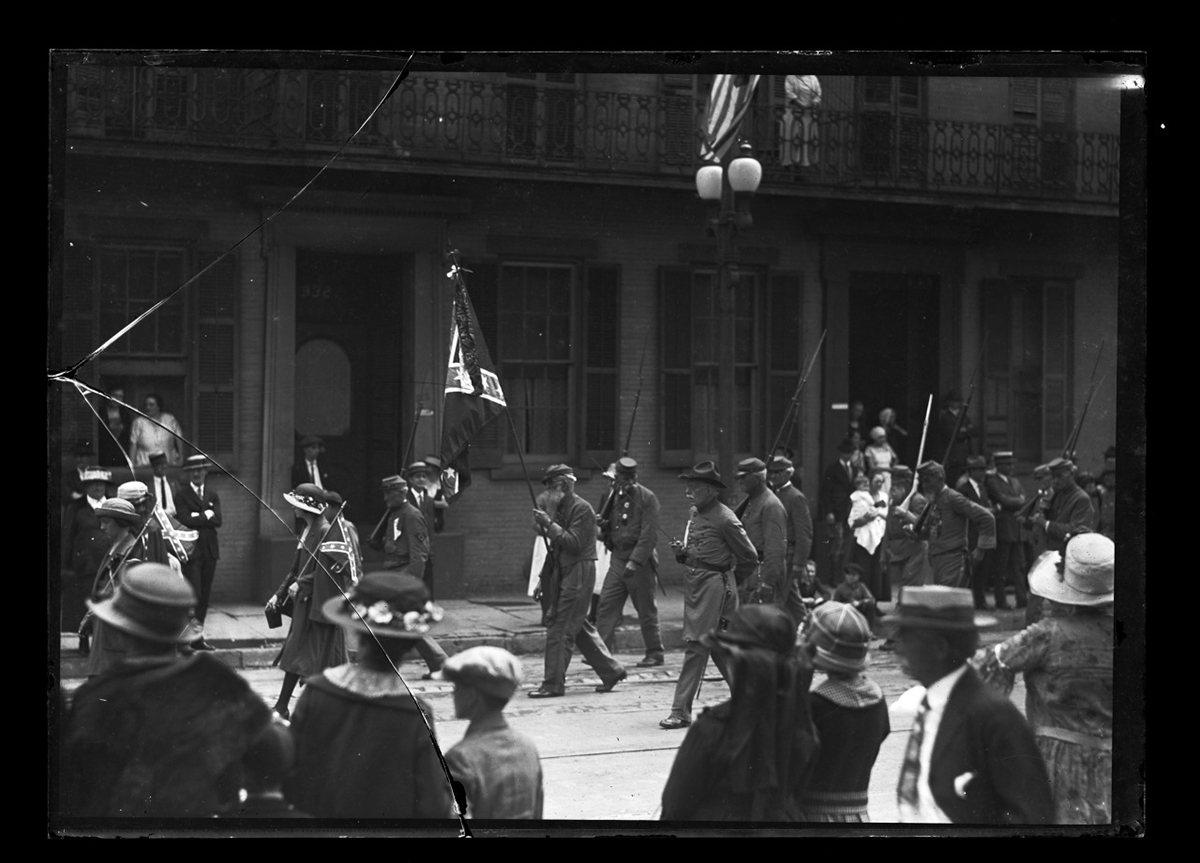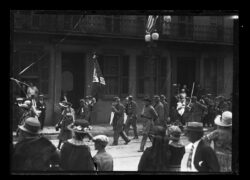Lost Cause
After the Civil War the grief of defeated Confederate supporters became an instrument of defiance and an ideology that justified segregation and white supremacy.

The Historic New Orleans Collection
A parade of Confederate veterans and their supporters, circa 1920.
The myth of the Lost Cause gave former Confederates a narrative for coping with the psychic trauma of defeat after the Civil War. Roughly 18 percent of white military-aged men died fighting for the Confederacy, an unprecedented population loss affecting society and culture more broadly. For bereaved families and communities, the notion that their loved ones did not sacrifice their lives for a noble purpose was simply unthinkable. Cemetery dedications and wreath-laying ceremonies invariably included an oration by a local dignitary about Southern men sacrificing themselves for honor, in defense of home and hearth, and for the rights inherent in the Constitution. These sentiments spread throughout the South as a civic religion, called the Lost Cause. By the 1880s Confederate apologists passed down principles of what they deemed indelible truths. First, they believed the South was not defeated militarily but rather overwhelmed by the superior numbers of an industrial juggernaut; second, that the Confederacy prevailed over its Northern counterpart through the brilliance of its officer corps and the valor of the Confederate soldier; third, that the antebellum South was a superior civilization home to an enlightened aristocracy and happy, loyal slaves; and lastly, that the war fought for states’ rights, not slavery. The myth of the Lost Cause has largely been debunked over time by historians for exaggeration, half-truths, and glaring omission (e.g., slavery), but for more than a century, the Lost Cause held sway as a social and cultural force over the whole country.
Origins and Growth
The “Lost Cause” as a term was coined by Richmond newspaper editor Edward Pollard in The Lost Cause: A Southern History of the War of the Confederates, published in 1866. The book predates the accepted Lost Cause orthodoxy because Pollard does not give the Confederacy a pass for losing the war on account of population and arms, instead blaming defeat on what he believed was the incompetence of the Confederate government, in particular, Jefferson Davis. Yet Pollard does celebrate the antebellum South for its “superior refinements of scholarship and manners,” and he calls for a “war of Ideas” to preserve Southern culture, tradition (i.e., white supremacy), and states’ rights, foreshadowing the South’s politics and social structure after Reconstruction.
Ex-Confederate generals contributed to the myth of the Lost Cause by writing histories and articles often justifying their own actions to right the historical record. The Southern Historical Society was founded in New Orleans by Confederate officers in 1869, four years after the Confederate surrender, and moved to Richmond in 1873. There, former General Jubal Early and a cadre of Virginians took over the organization and published battle accounts in the Society’s organ, the Southern Historical Papers, always from a Confederate perspective. The most effective propagandist for the Lost Cause was Early himself, who, through a prolific output of commentaries, glorified the Confederacy, lionized Robert E. Lee, and settled old scores by directing his vitriol at Lee’s much-maligned second-in-command James Longstreet, who had gone over to the Republican Party.
By the late nineteenth century, the Lost Cause and postwar reconciliation became two sides of the same coin. If the North recognized Southern courage and military prowess and the South was willing to forego slavery and secession, Civil War veterans could rebuild the country making for an even stronger nation. In one of the great acts of Gilded Age trickery, Confederate and American patriotism became conflated. Confederate monument dedications often included Union veterans with the American flag flying alongside the Confederate battle flag. Part of reconciliation was for Americans to frame the tragedy of 750,000 deaths (7 percent of Northern men of military age and 18 percent of white Southerners of military age) in classical heroic terms. Americans looked to the classics for to understand the war, like Homer’s epic poem The Iliad, a heroic narrative of the war between the ancient Greek kingdoms and the city of Troy circa 1200 BCE. If the South was the new Troy, Robert E. Lee was its Hector. According to historian Thomas Connelly, Lee became a national hero because he personified a pre-industrial America, an alternative to the new class of wealthy industrialists that dominated the country. But not everyone applauded Lee’s deification. According to historian David W. Blight, “African Americans reacted to the Lee cult generally … with a combination of silence and defiance.” Frederick Douglass had warned just a year after Lee’s death in 1871 of a “devoutly cherished sentiment inseparately identified with the [Lost Cause].”
Politicizing History
In 1891 the history committee of the United Confederate Veterans met at Memorial Hall in New Orleans to develop a report on textbooks with what they viewed as a suitable interpretation of the war. The committee, run by former Confederate general and math professor E. Kirby Smith, regarded any textbook that used the word “rebellion” or that mentioned slavery as a cause of the war as objectionable. The committee’s 1894 final report stated in no uncertain terms that “The true cause of the war between the states was the dignified withdrawal of the Southern States from the Union, to avoid the continued breaches of domestic tranquility, guaranteed but not consummated by the [C]onstitution.”
In 1900 the United Confederate Veterans issued a report in which the Confederate veteran could claim a political victory over the policies of Reconstruction as well as a “social victory by which he restored the time-honored institutions and redeemed social fabric.” The period between 1890 and 1910 not only secured Lost Cause ideology as a civic religion in the South but also solidified white supremacy with Jim Crow legislation and Black disfranchisement. During this period lynching also increased. Between 1897 and 1906 white mobs lynched 884 Black people, mainly in the South.
Southern women’s groups acted as shock troops to enforce the suitable interpretation of the war. The Ladies Confederate Memorial Association, founded in 1866, and the United Daughters of the Confederacy, established in 1894, sought to keep Confederate memory alive and eliminate threats to the Lost Cause orthodoxy. In Louisiana both groups called for the removal of Julia Ward Howe’s “Battle Hymn of the Republic” from public schools in 1905, and as late as 1929, there was a move by the United Daughters of the Confederacy to censure any child that participated in events honoring Lincoln By the new century, monument dedications and memorial ceremonies were largely in the hands of women-led Confederate memorial groups. And they were prodigious fundraisers—Catherine Walker Behan, national president of Confederated Memorial Associations, procured the necessary funds for Jefferson Davis monuments in both Richmond and New Orleans. Her husband William Behan of the New Orleans Washington Artillery surrendered with Lee at Appomattox. Both the Ladies Confederate Memorial Association and the United Daughters of the Confederacy policed textbooks, sponsored essay contests on Confederate heroes, and included children at all memorials and dedications.
Yet the Lost Cause lasted because it had a national appeal. That the states’ rights argument as a cause not only ignored historical evidence (e.g., secession ordinances and the “Cornerstone” speech of Confederate Vice President Alexander Stephens) but also justified white supremacy and Jim Crow laws in the South was an inconvenient truth for the rest of the country. Scholars like William Dunning of Columbia University sanctioned the Lost Cause by deeming Reconstruction an abject failure, which was popularized in D.W. Griffith’s 1915 silent film The Birth of a Nation, portraying the Ku Klux Klan as heroes. Margaret Mitchell’s 1936 novel Gone with the Wind, the most romanticized version of the Lost Cause, topped the bestsellers list in 1937 and 1938 and was released as a blockbuster film in 1939. While historians came to acknowledge slavery as an issue dividing North and South, it remained in the background through the middle of the twentieth century. Academics Charles and Mary Beard, for example, writing in the 1930s used a Marxist lens to describe how an industrialized, capitalist North overpowered a more agrarian South. In the 1950s Southern historian Avery Craven saw the cause as a failure of democracy with irrational people on both sides bringing the country into war, and Daniel Boorstin, as part of the Consensus School of historians, viewed the war coming out of differing sectional interpretations of the Constitution.
Correcting History
Nevertheless, Abraham Lincoln knew the cause of the war to be slavery, as he articulated in his Second Inaugural Address. But the demands of reconciliation in the late nineteenth century made Americans and the historian community reluctant to see the war in moral terms—a misunderstanding between the old Union and Confederate states was far more palatable if the nation were to move forward. When James Ford Rhodes published the first two volumes of his History of the United States in 1892 and asserted the war was caused by slavery, scholars and history buffs went on the attack. Yet after World War II, the moral weight of the Holocaust and the American civil rights movement rendered a moral interpretation of the Civil War an imperative for understanding its true legacy. Historians Arthur Schlesinger Jr., Eric Foner, David Blight, Barbara Fields, and a host of other scholars realigned Civil War historiography, and states’ rights theory, while a still-favored view of the war by some groups lost any intellectual legitimacy for serious students of history.
There are other omissions in the Lost Cause spectacle. Robert E. Lee was a great general but so, too, were Ulysses S. Grant and William T. Sherman. The North had a decided advantage in industrial output, but the South put together an impressive war economy including the second-largest gunpowder plant in the world at Augusta, Georgia. Confederate troops were not superior nor inferior to their Northern counterparts. The North had a better military strategy in advancing on all fronts effectively preventing the South from moving troops where they needed them. The scarcity of universities, scientists, and intellectuals in the antebellum South hardly evinces a superior civilization. Nevertheless, the romance of the Lost Cause made for a compelling story in the 1890s when the country was experiencing unprecedented change. The story of a region tied to tradition, honor, and chivalry fighting for principle—even in the face of certain defeat—became an American story.
Yet there is always a cost when myth and commemoration assume historical certainty. As author James Baldwin writes in his 1963 book The Fire Next Time, “To accept one’s past—one’s history—is not the same as drowning in it; it is learning how to use it. An invented past can never be used; it cracks and crumbles under the pressure of life like clay in a season of drought.” As the Lost Cause promoted flawed history its romantic edifice began to crack. Its rhetoric and monuments could not hide the essential truth that the Confederacy fought to preserve a slave-holding republic.
But myths contain half-truths; otherwise, the Lost Cause would not have survived for as long as it did. The communal grief the Confederate Southerners suffered from the war was very real, and it is fair to say the Lost Cause came out of a profound sense of tragedy. Nevertheless, it became an instrument of defiance and an ideology that justified segregation and white supremacy. This was laid bare in the 1950s and 1960s when the Lost Cause enjoyed a resurgence as a response to the civil rights movement and the Civil War centennial. That the Lost Cause consciously removed slavery from the narrative can only be described as historical wrongdoing. And the removal of Confederate monuments in the twenty-first century was part of an attempt to right the historical record.
